
This is the first article in a series of three about how Brazil’s census bureau, IBGE, held an unprecedented week-long workshop to debate how to change the term “subnormal agglomeration” used for decades to describe the nation’s informal settlements, from the perspective of favelas and working-class communities.
From September 25-28, 2023, leaders from favelas, urban communities, tidal lands, flood lands, mangroves, stilt communities, villages, valleys, hillsides, self-constructed settlements, working-class settlements, invasions, grottos, neighborhoods, occupations, hoods, glens, lowlands, Afro-Brazilian mocambos and ressacas, formal and informal subdivisions, and improvised villages (as they all self-identified), together with employees and researchers from the Brazilian Institute of Geography and Statistics (IBGE), met online and in Brasília for the First National Meeting for the Production, Analysis and Dissemination of Information about Favelas and Urban Communities in Brazil. With approximately 80 daily attendees, the event was also viewed online by hundreds of interested parties.
The main objective was to discuss the term—subnormal agglomerations—officially used since the mid-1990s to define favelas and other urban communities in the census. For decades, bureaucrats and researchers at IBGE have heard discontent with this stereotyped definition of favelas, and have observed that residents of these areas do not identify with this official category. Cláudio Stenner, Director of Geosciences at IBGE, described how they were already thinking about changing the term at a conference held in 2006, but that due to the “absolute difficulty of having a consensus on another name that represented these territories in the country,” it was not possible to change the term at that time.
“Hearing ‘subnormal agglomeration’ is always very sad and annoying for us from peripheral areas and favelas. We need to change this as soon as possible.” — Laís Borges, Favelas Museum/São Paulo
As a result, after the 2022 Census, IBGE decided to promote a national meeting as a space for exchange between community leaders and the institution with the aim of replacing the term. “We need better concepts to better understand the Brazilian reality,” summarized Marcio Pochmann, current president of the institute.
“[The objective of the event is] to equip society with better conditions for thinking and planning these areas that are an integral part of the core of Brazil, of Brazil’s identity, and Brazilian society.” — Cláudio Stenner, Director of Geosciences at IBGE
The idea is that based on the discussions held during the event a new terminology with greater explanatory power, which generates self-identification among residents, will become the new standard.
“You can’t build a concept from what it is not. Therefore, I do not consider subnormal agglomerations a concept since it is based on denial and lacking. It is not built on what in fact it is. It doesn’t even explain what ‘normal’ is in relation to the subnormal.” — Jailson de Souza e Silva, native of Mangueirinha Favela in Brás de Pina, founder of CEASM and the Favelas Observatory, professor, and public employee of BNDES
On different occasions, this process of reflection on the power of naming and producing data reinforced how what is now defined as subnormal agglomerations are urban communities that are very different from each other, with distinct historical and social formation processes. Activists and leaders from Rio de Janeiro and São Paulo present at the event encourage the use of the term favela as a matter of identity.
“A favela is a favela; community can be a condominium, a group. I think community can be strange and is used a lot by churches, which is perhaps triggering. Many organizations defend the term favela due to the political and narrative dispute.” — Michel Silva, Fala Roça
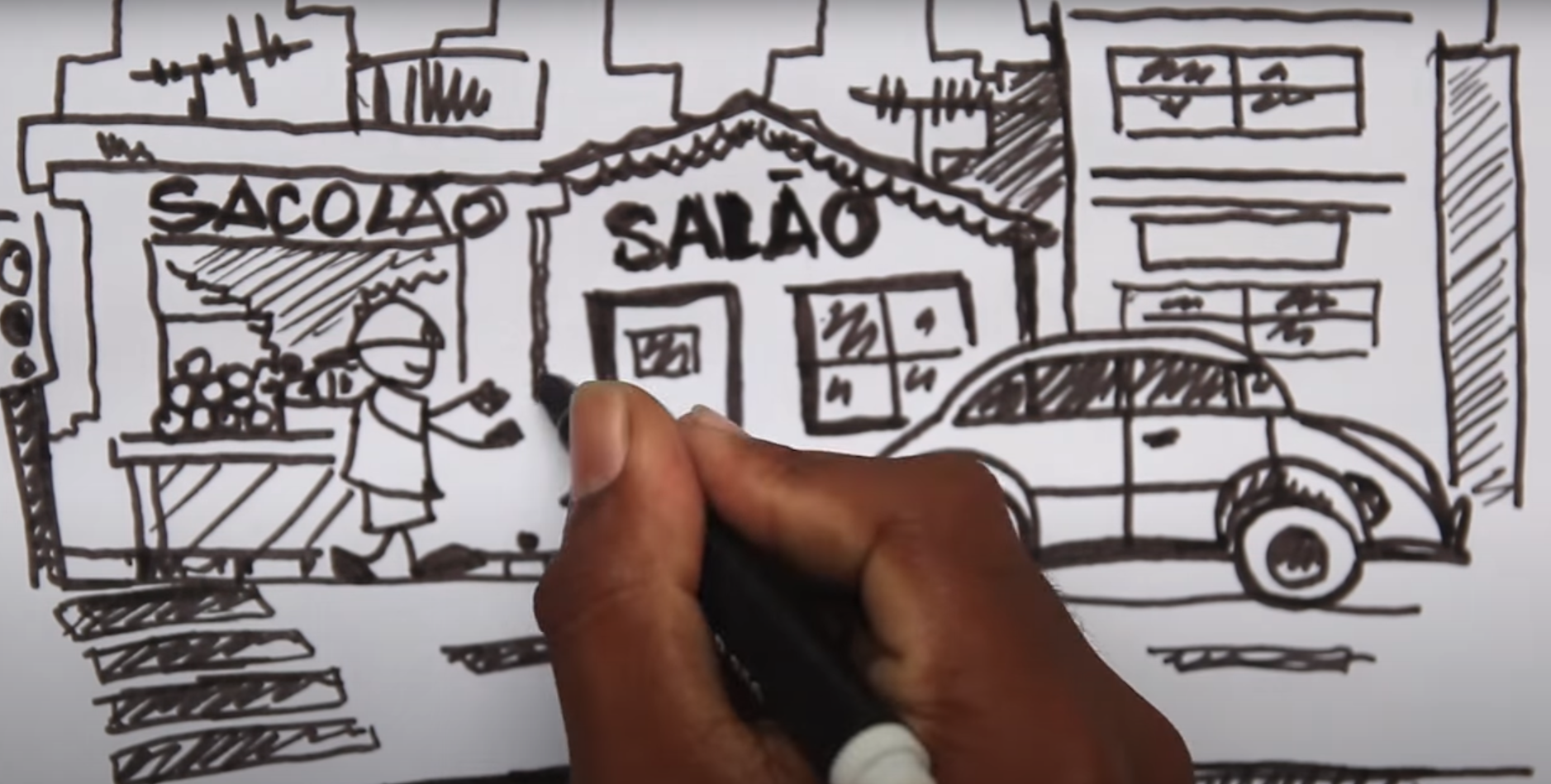
“It is essential to carry the word ‘favela’ into this new term. This is something beyond a territorial denomination; rather, it is an element of identity, an affective space that is organized by residents, artists, and others who live the favela.” — Preto Zezé, Central Única das Favelas (CUFA)
However, it was stated that the term favela does not result in such self-identification among residents outside the Brazilian southeast. Thus, simply changing the current word to favelas would continue to be insufficient.
“The term favela has been used a lot in Rio and São Paulo, but in other places, talking to residents and employees, there was a lot of ‘there are no favelas here.’ Using this term was a problem, we needed to survey these places and the name was a problem. There was a notion that ‘favelas’ were the hills of Rio de Janeiro and seen as something negative… [We carried out] a series of qualitative field studies to understand what these areas were. And we saw that the names and forms of territorial occupation were very diverse: invasion, stilt houses, grottos, neighborhoods, etc.” — Claudio Stenner
On the other hand, many of these leaders, unlike those in Rio and São Paulo, do not oppose the use of the term community. It is important to understand that for a long time in the southeast, the term ‘community’ was used to render the favela invisible. However, in other states, community is the term most used and with which residents most identify.
“For me, living in the southeast, ‘community’ is not a term I like. I don’t feel represented by it… I feel a sanitizing, masking logic. However, peripheral and favela people from the center-west, north and northeast love the term and feel represented…” — Laís Borges
“In Ceará, we use favela, community, and neighborhood… yes, there is a stigma to using the term favela and there is a movement that wants to do away with this term… In Rio and São Paulo, it is the term used most, but I think it’s used a lot to generate media… The term community is used more in Ceará… but I think both must remain [in the new IBGE nomenclature].” — Ivan Batista, Federation of Neighborhood and Favela Entities of Fortaleza
There was thus a consensus at the event that any discussions that do not recognize the enormous diversity among these disinvested, informally-built urban communities in a country the size of Brazil will be fruitless. It became clear to everyone that the diversity of these areas must be central in the search for a new term to designate favelas and similar urban settlements.
Favelas and Urban Communities at IBGE: Challenges and Perspectives
At the event opening, geographers and urban planners from IBGE began by outlining the history of the term being discussed, making it clear that subnormal agglomerations was adopted over 30 years ago due to a lack of better nomenclature and consensus around other names.
“Keeping the term [subnormal agglomerations] was a strategy to avoid focusing on this and focus on mapping [the country]. But I already knew at that time that this name was horrible. That it did not represent these areas from a social point of view. That it stands from the outside, looking in: exogenous to the populations and not representing the views of those populations.” — Claudio Stenner

Director of Geosciences Claudio Stenner, Superintendent Gabriel Moreira, and Geography Coordinator of the Geosciences Directorate Cayo de Oliveira Franco, presented the criteria for defining, analyzing, and referencing areas understood as subnormal agglomerations. They brought some suggestions for changes and opened an online form where participants could share suggestions on nomenclature, definitions, methods, etc. The data collected from this form along with all the qualitative data from the week’s discussions were presented and summarized in a letter, which was read and edited during the last plenary session of the workshop.
IBGE employees stated that research is underway to understand why the subnormal agglomerations category was adopted. But, despite this error, they praised the history of the institute, which has been producing data specifically on favelas and related areas since the 1950s.
“IBGE investigated [favelas] for the first time in the 1950 Census, and this was well ahead of what other groups did. In 1991, it switched to subnormal agglomerations. We have little documentation, but we are studying to understand how this came about… What is the subnormal agglomeration: irregular occupation of land (foremost), precarity of essential public services, etc.” — Cayo de Oliveira Franco
Prior to the seminar, IBGE employees looked at how notable organizations such as the Favelas Observatory and UN-Habitat Brazil defined these areas. With this, it was possible to bring a basic proposal to the event that would serve as a working foundation.
“We are also trying to remove this narrative of denial, of irregularity, and instead talk about how these territories should be defined in terms of their pursuit of rights. So, we changed the logic from ‘oh man, it’s irregular’ to ‘rights are not being offered,’ in the most diverse aspects.” — Cayo de Oliveira Franco
Favelas and Brazilian Urban Communities: Rethinking the Nomenclature of Subnormal Agglomerations
Daiane Ciriáco, project assistant of Geography Coordination at IBGE, praised the opportunity for these discussions. She stated that there has been an internal intention to review the term subnormal agglomeration at IBGE for almost 20 years. According to Ciriáco, the resident-led process, which was being strengthened at this meeting, is the best way to implement this change and arrive at a new nomenclature and classification of these areas.
“We have to listen to [community] actors and work together; it’s the best path that’s being taken by IBGE…” — Daiane Ciriáco
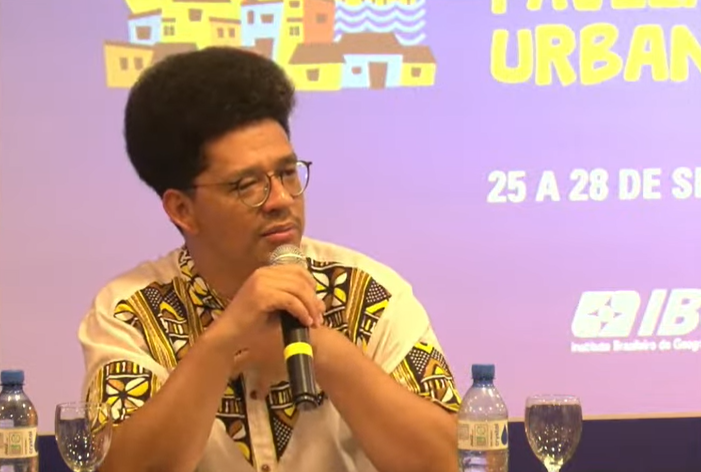
As a favela native, Guilherme Simões, the National Secretary of Peripheries, explains some of his feeling of estrangement and unfamiliarity around the category subnormal agglomerations when it was introduced to him at university. According to the Secretary, favelas offer autonomous solutions in the absence of the State. For Simões, it is this powerful aspect of these territories that should be reflected in IBGE research and should be mapped.
“I’m from Grajaú, a region that in the 2000s was known for danger… When I graduated in 2010 and read the term ‘subnormal agglomeration,’ I found it strange and inappropriate… ‘subnormal’ helps to create narratives, images, and symbols… The periphery is power! Despite the absence of the State, a favela economy developed because the people had to come together… I would like to see this in the research… These guys built real survival networks.” — Guilherme Simões
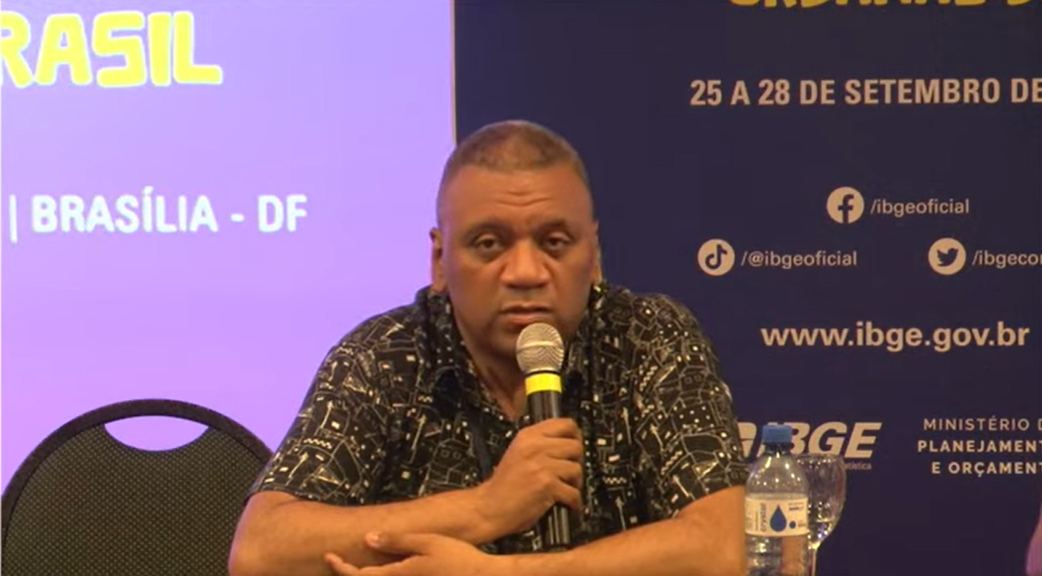
Preto Zezé, born and raised in the Favela das Quadras in Fortaleza, capital of Ceará, and currently global president of CUFA, remembers the historical stigma surrounding favelas, but praises the advances resulting from the struggle of residents.
“Favelas were synonymous with fear. If you looked on the Internet you’d only see disgrace, and nowadays you can find other things. We’ve advanced in terms of awareness, in the struggle. We have a historic challenge against the stigma about favelas and those who come from favelas.” — Preto Zezé
Furthermore, Preto Zezé contextualizes the importance of producing data both for government actions through public policies and for movements operating in favelas and working-class territories. The budget invested in these areas only stems from the data, hence the urgency in producing them whether by IBGE and other public bodies or through ‘by us for us’ methodologies.
“It is also in our interest to produce data, as it qualifies our actions… for the governance of the territory… That’s the importance of IBGE for us, movements… It is the democratization of data and information being brought to the population… We also need to transform this into a budget, give it an economic slant, and not just focus on the discourse of democratic legitimacy.” — Preto Zezé
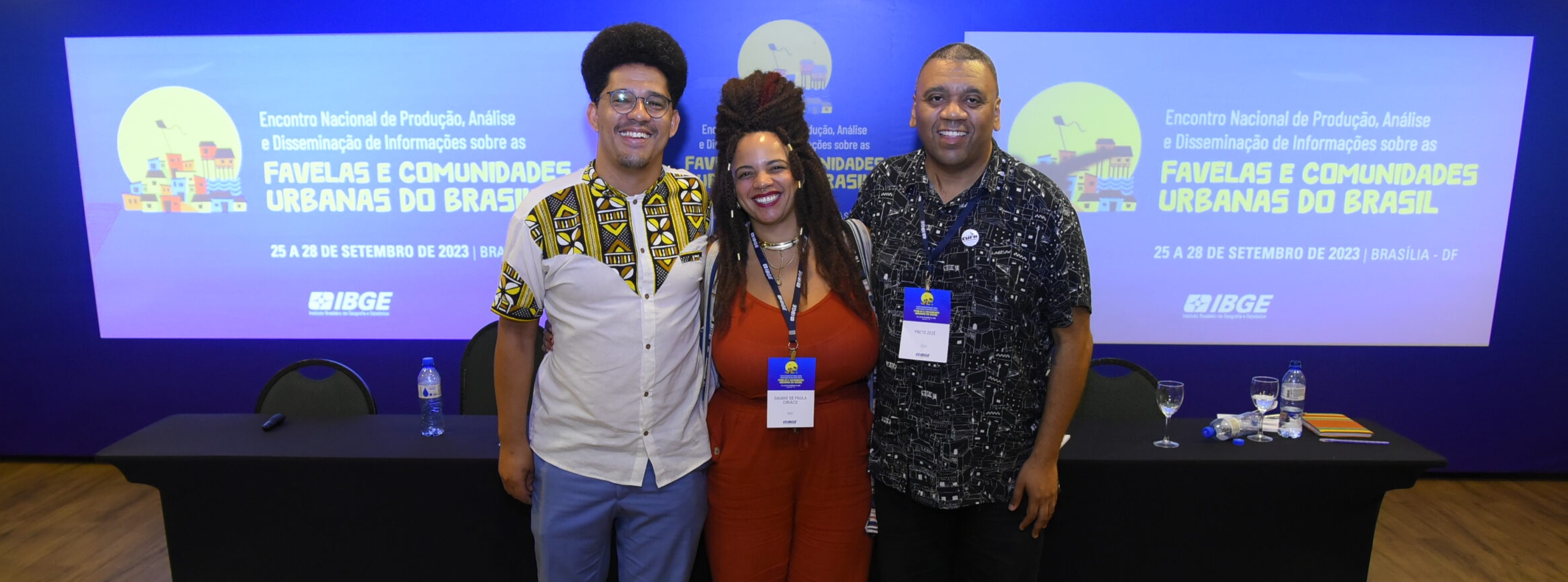
Raquel Rolnik, former Special Rapporteur to the UN on Adequate Housing and professor at the University of São Paulo’s LabCidade, went a step further and stated that the term “subnormal” should be understood as the result of a long urbanist tradition that is colonial and racist.
“We cannot help but think that this is a colonial landmark… it is part of a way of thinking about territory that has to do with the construction of knowledge and power, where only one model for cities is recognized as hegemonic… the Western model, that is patriarchal and European. That is [considered] ‘normal’… From this point on, we begin to define whatever is outside this dominant standard as informal, irregular, illegal, defined by want and lacking. And not by the characteristics present in the territory.” — Raquel Rolnik
For the professor, naming the area is fundamental for the politics of cities. It is important that these territories claim their right to the city.
Territorial Diversity of Favelas and Brazilian Urban Communities
Faced with territorial diversity that translates into very distinct nomenclatures and types of occupation that are highly diverse, whether on hills, stilts, horizontal subdivisions, or valley floors, it is necessary to establish a methodology that ensures statistical comparability between subnormal agglomerations and the new category, stemming from diverse territorial variations. The last panel on the first day of the meeting presented and discussed these variations, aiming to develop a new typology that better represents these territories in all their diversity.
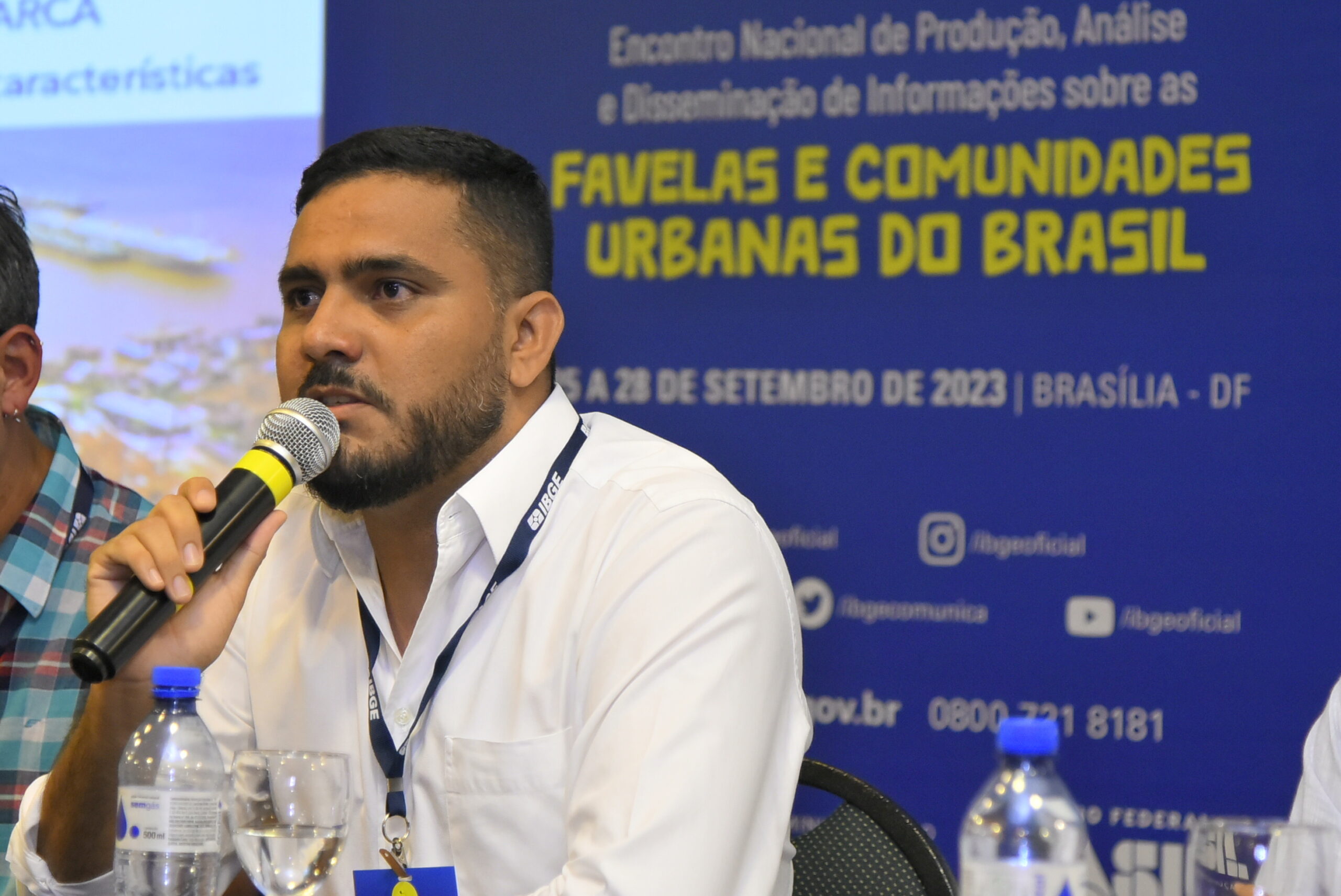
Gerson Bruno, general coordinator of the Vila da Barca Residents’ Association, located on the banks of Guajará Bay, in Belém, in the state of Pará, which is one of the largest communities on stilts in Latin America, highlights the lack of investments to guarantee decent living conditions for residents in Vila da Barca at the same time federal resources are abundant for COP 30, which will be held in the same city.
“In Vila da Barca, for almost 100 years, we have been resisting in order to exist… The capital of Pará will host COP 30 in 2025… they are thinking about where the Sheikh will sleep, where the heads of state will stay, while we have brothers and sisters living in stilt structures without basic sanitation, without drinking water.” — Gerson Bruno
He also praises the residents’ struggle and affirmed that, in his opinion, it should be the leading figure in narratives about communities like his.
“In our community, we have a memorial museum that we created with a project [financed] through the Aldir Blanc Law to record the history of the village for the next generations, like how it came to be, the struggles for water… we had to carry water on our heads… I’m talking about some of the most valuable land in Belém. We live under great pressure to leave that place, but we continue resisting!… There is the question of belonging… we don’t accept removal of any resident from the Vila to a housing complex, only within the same location.” — Gerson Bruno
Gerson also denounced local government neglect in implementing the Zero Stilts Program launched during the first administration of President Lula.
“Today, we estimate that there are over 7,000 stilt houses in Vila da Barca, originally made up of riverbank communities and people from the interior who came in search of making a living in the big city. The housing project neglected us so much that, in the last municipal administration, they simply reduced the goals and cut the project in half and said: ‘look, from today onwards, only these families will be eligible. These others won’t’… 80% of Vila da Barca will remain on stilts… this is because they are struggling to deliver it for the COP..” — Gerson Bruno
Reinforcing Gerson’s reports and analysis, Maikon Novaes, manager of Research and Territorial Classification in the Geography Coordination of the IBGE Geosciences Directorate, stated that “IBGE classifies over 50% of Belém’s households as favelas and urban communities.” This makes the level of State negligence and violations of the right to housing in Belém even clearer.
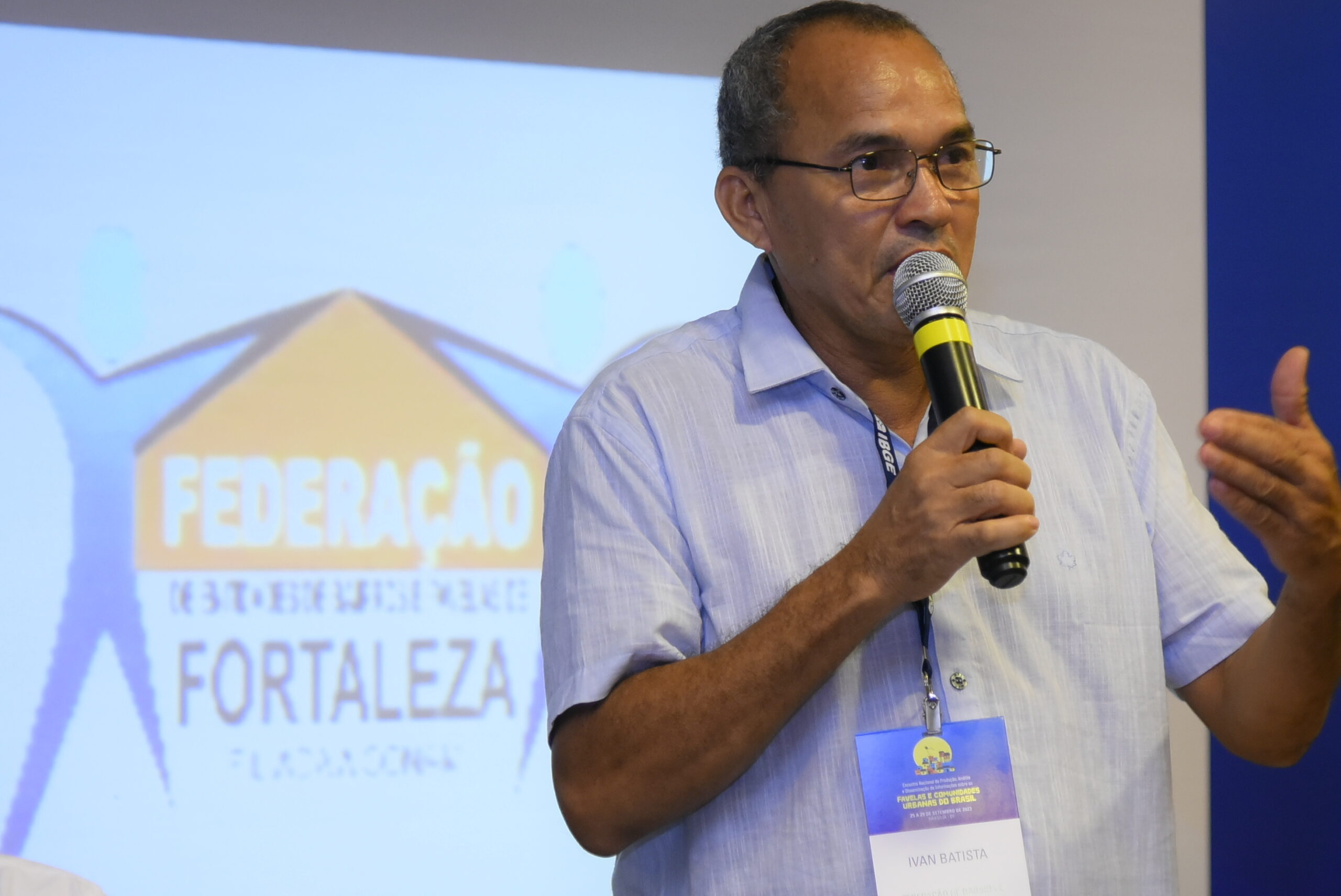
Ivan Batista, president of the Federation of Neighborhood and Favela Entities of Fortaleza, highlights the actions of the organization he is part of for combating Fortaleza’s glaring housing deficit. He speaks with pride that the federation managed to build housing through the Minha Casa Minha Vida-Entidades self-build program. In his speech, he compares these results with those achieved by the private-public-build Minha Casa Minha Vida housing program in his region. According to him, when residents take the lead, the process is much more successful.
“We built the largest housing complex with 1,846 homes… through the Minha Casa Minha Vida [Entidades] program, which gave communities the opportunity to build… There are other complexes… we see the difference between the one built by us and the one built by the government… The housing deficit in Fortaleza is 130,000 homes… there are 89 risk areas, but according to City Hall, they don’t add up to 40… We do monitoring, we visit the communities… in mangroves, lagoons, streams… and we include all of this in the project to revise the master plan [of Fortaleza], in which [community] leaders are participating.” — Ivan Batista
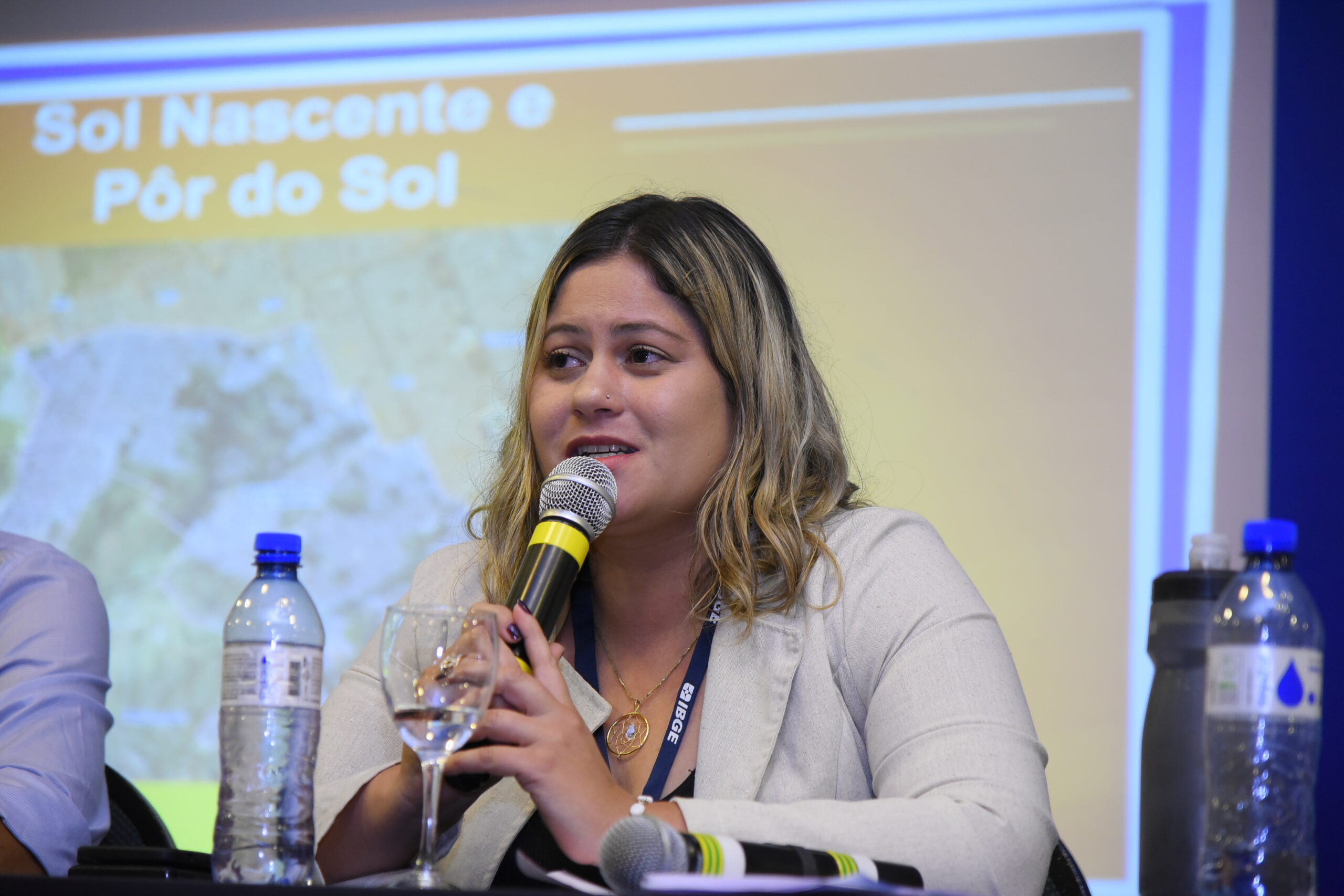
Maria Aline Correia Schimidt, director of the Sol Nascente Housing Federation (FEHSOLNA) and advisor to G10 Favelas in the Federal District, also spoke about protagonism and community struggles for the right to housing. She began her contribution by talking about the history of the area and how, despite being socialized the same way as favelas, they do not like to be identified by this term.
“Sol Nascente was born with the expansion of Ceilândia, founded in 1990… It has urban development problems, but it is already urbanized… Most of Sol Nascente does not have many problems with rain, but section 3 of Sol Nascente has more problems… Land grabbers took advantage and sold slopes, ravines, and the banks of the river in bad faith. That section has the characteristics of favelas, [but] we don’t like this term, we use ‘community.’” — Maria Aline Correia Schmidt
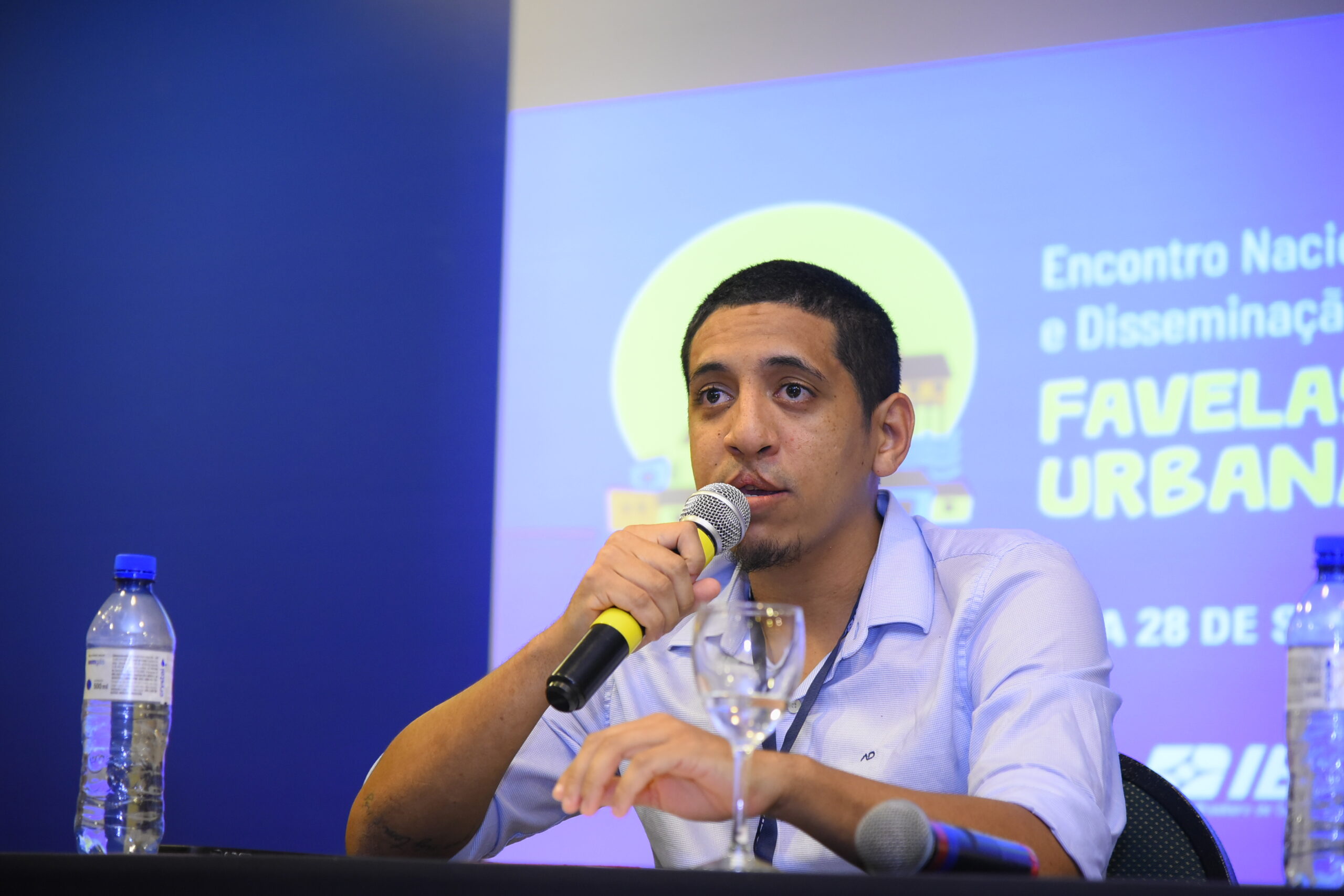
This was immediately responded to by Michel Silva, a native of Rocinha and founder of the newspaper Fala Roça, who highlighted the importance of the term favela in relation to the word community. He described that, like many in Rio, he abhors the term community. “Favela is the city, it’s important to keep the term because of its origin… From the very start, they already wanted to exterminate the favela, so we must resist.”
The journalist highlighted how IBGE’s partnership with leaders and organizations in favelas and working-class settlements is strategic. For him, getting good word done is not a problem for favela residents. What is missing are financial resources.
“Favelas have the capacity to provide very specific data that IBGE does not have. But once again, we come up against the issue of money… It’s important to highlight that we have very large capabilities not only to generate data, but also to move money… We have the capacity to manage money. This is important, because there are many philanthropic organizations that are resistant to transferring funds that favela organizations can manage.” — Michel Silva
This is the first article in a series of three about how Brazil’s census bureau, IBGE, held an unprecedented week-long workshop to debate how to change the term “subnormal agglomeration” used for decades to describe the nation’s informal settlements, from the perspective of favelas and working-class communities.
About the author: Julio Santos Filho has a Bachelor’s in International Relations (UFF) and a Master’s in Sociology (IESP-UERJ). A Black man from Ilha do Governador, he has worked as editor of RioOnWatch since 2020. In 2021, he edited the series “Rooting Anti-Racism in the Favelas”, a silver medalist in The Anthem Awards.
